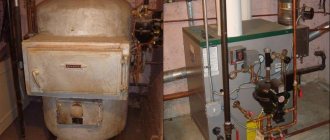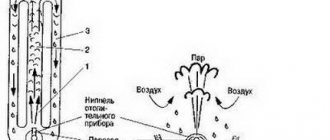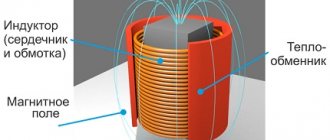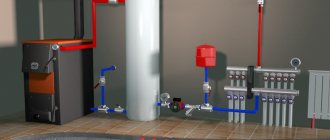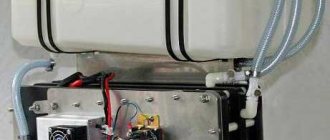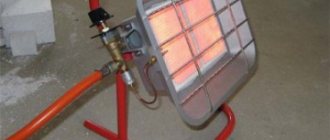Geothermal heating from underground: what is it, how does it work?
Geothermal heating works like a refrigerator , only for heating. A heat pump is installed on the surface of the earth, from which a heat exchanger is lowered into the shaft.
Groundwater flows upward through the device, heating up along the way. The heated liquid is used to heat rooms.
Energy consumption for heating water is less than the resulting heat transfer.
Principle of operation
The collector supplies warm water to the evaporator. The refrigerant heats up and evaporates. The steam is heated by a compressor using electricity. The condenser cools the steam, causing the release of warm energy and the refrigerant returning to its original liquid state.
Electricity is required to heat water. Each kW spent brings , on average, 5 useful kW of energy.
Equipment list
To create a geothermal installation, 4 devices are required:
- collector;
- evaporator with refrigerant;
- compressor;
- capacitor.
Among the listed components, two require an electrical connection: the compressor and the condenser.
Advantages
Geothermal heating has advantages over other types of heating:
- The resulting energy is used for any purpose .
- The duration of fuel supply to a specific area is not limited .
- Its use is environmentally friendly.
- The installation does not require frequent maintenance.
- The system pays for itself over time.
- A geothermal installation takes up little space: no more than a refrigerator.
- If necessary, the system can be easily reconfigured.
- Compatible with other types of heating.
Flaws
Although geothermal heating has many advantages, it also has disadvantages:
- Expensive system and installation.
- Pays for itself in about 10 years.
- The system cannot be used in areas with temperatures falling below 20 degrees.
- Regardless of the type of installation, extensive excavation work using rental equipment.
Methods for collecting the Earth's energy resources
Today there are three main methods for collecting geothermal energy: dry steam, hot water and the binary cycle. The dry steam process directly drives the turbine drives of electricity generators. Hot water flows from the bottom up, then is sprayed into the tank to create steam to drive the turbines. These two methods are the most common, generating hundreds of megawatts of electricity in the US, Iceland, Europe, Russia and other countries. But location is limited, as these plants operate only in tectonic regions where access to heated water is easier.
With binary cycle technology, warm (not necessarily hot) water is brought to the surface and combined with butane or pentane, which has a low boiling point. This liquid is pumped through a heat exchanger where it is evaporated and sent through a turbine before being recirculated back into the system. Binary cycle technologies provide tens of megawatts of electricity in the United States: California, Nevada and Hawaii.
The principle of energy production
Disadvantages of Geothermal Energy
At the utility level, geothermal power plants are expensive to build and operate. Finding a suitable location requires expensive well surveys with no guarantee of hitting a productive underground hot spot. However, analysts expect this capacity to nearly double over the next six years.
In addition, areas with high underground source temperatures are located in areas with active geological and chemical volcanoes. These "hot spots" form at the boundaries of tectonic plates in places where the crust is quite thin. The Pacific region, often referred to as the ring of fire for many volcanoes, has many hot spots, including in Alaska, California and Oregon. Nevada has hundreds of hot spots covering much of the northern United States.
There are other seismically active areas. Earthquakes and the movement of magma allow the water to circulate. In some places, water rises to the surface and natural hot springs and geysers occur, such as in Kamchatka. The water in the geysers of Kamchatka reaches 95° C.
One of the problems with an open geyser system is the release of certain air pollutants. Hydrogen sulfide is a toxic gas with a very recognizable "rotten egg" smell - small amounts of arsenic and minerals released in the steam. Salt can also pose an environmental problem.
In offshore geothermal power plants, significant amounts of interfering salt accumulate in the pipes. In closed systems there are no emissions and all liquid brought to the surface is returned.
Economic potential of the energy resource
Seismically active spots are not the only places where geothermal energy can be found. There is a constant supply of useful heat for direct heating purposes at depths anywhere from 4 meters to several kilometers below the surface almost anywhere on earth. Even the ground in your own backyard or local school has economic potential in the form of heat to be released into your home or other buildings.
In addition, there is a huge amount of thermal energy in dry rock formations very deep below the surface (4 – 10 km).
Using the new technology could expand geothermal systems, where people could use that heat to produce electricity on a much larger scale than conventional technologies. The first demonstration projects of this principle of generating electricity were shown in the United States and Australia back in 2013.
If the full economic potential of geothermal resources can be realized, it will represent a huge source of electricity for production capacity. Scientists estimate that conventional geothermal sources have a potential of 38,000 MW, which can produce 380 million MW of electricity per year.
Hot dry rocks occur at depths of 5 to 8 km everywhere underground and at shallower depths in certain places. Access to these resources involves the introduction of cold water, circulation through hot rocks and the removal of heated water. There are currently no commercial applications for this technology. Existing technologies do not yet allow the recovery of thermal energy directly from magma, very deeply, but this is the most powerful resource of geothermal energy.
With the combination of energy resources and its consistency, geothermal energy can play an indispensable role as a cleaner, more sustainable energy system.
How to make a unit with your own hands?
Regardless of which resource option (earth, water or air) is chosen for heating, a pump will be needed for the system to function correctly.
This device consists of the following elements:
- compressor unit (intermediate element of the complex);
- evaporator , transferring low-potential energy to the coolant;
- throttle valve , through which the refrigerant finds its way back to the evaporator;
- condenser , where freon releases thermal energy and is cooled to its original temperature.
You can purchase a complete system from the manufacturer, but this will cost a decent amount. When there is no free money at hand, it is worth making a heat pump with your own hands from the parts at your disposal and, if necessary, purchasing the missing spare parts.
When planning to install a geothermal heating system in a private home, you first need to take care of reducing the level of heat loss. To do this, the walls must be insulated with special material, the doors and window frames must be equipped with foam pads, and the floor and ceiling must be protected with foam panels. Then the maximum amount of heat released by the pump will remain inside the room.
When the decision to make your own heat pump is made, you must definitely check the condition of the electrical wiring and electric meter in the house.
If these elements are worn out and old, it is necessary to inspect all areas, identify possible faults and eliminate them before starting work. Then the system will work flawlessly immediately after startup and will not bother the owners with short circuits, fires in wiring, or knocked out plugs.
Method #1. Assembly from the refrigerator
To assemble the heat pump with your own hands, remove the coil located at the back from the old refrigerator. This part is used as a capacitor and is placed in a highly durable container that is resistant to aggressive temperatures. A properly working compressor is attached to it, and a simple plastic barrel is used as an evaporator.
If a very old refrigerator is used to create a pump, it is better to replace the freon in it with a new one. You won’t be able to do this on your own, so you will have to invite a specialist with special equipment. It will quickly replace the working fluid, and the system will work in the desired mode
The prepared elements are connected to each other, and then the created unit is connected to the heating system through polymer pipes and the operation of the equipment begins.
Step-by-step instructions for assembling a heat pump from a refrigerator are described in this article.
Method #2. Heat pump from air conditioner
In order to make a heat pump, the air conditioner is modified and some main components are redesigned. First, the outdoor and indoor units are swapped.
The evaporator, which is responsible for transferring low-grade heat, is not additionally installed, since it is located in the internal block of the unit, and the condenser transmitting thermal energy is located in the external block. Both air and water are suitable as coolants.
If this installation option is not convenient, the condenser is installed in a separate tank designed for correct heat exchange between the heating resource and the coolant.
The system itself is equipped with a four-way valve. For this work, a specialist with professional skills and experience in conducting events of this kind is usually invited.
Modern split systems are ineffective at low temperatures, so professionals do not recommend using them for making heat pumps yourself
In the third option, the air conditioner is completely disassembled into its component parts, and then a pump is assembled from them according to the traditional generally accepted scheme: evaporator, compressor, condenser. The finished device is connected to the equipment heating the house and started to be used.
The site has a series of articles on making heat pumps with your own hands, we recommend that you read:
- How to make a heat pump for heating a house with your own hands: operating principle and assembly diagrams
- How to make an air-to-water heat pump: device diagrams and self-assembly
Classification by construction type
The operating principle of geothermal heating is similar to that of an air conditioner or refrigerator. The main element is a heat pump included in two circuits.
Operating principle of a geothermal (heat) pump
The internal circuit is a traditional heating system consisting of pipes and radiators. External - an impressively sized heat exchanger located underground or in the water column. Both a special liquid with antifreeze and ordinary water can circulate inside it. The coolant takes on the temperature of the medium and, “warmed up,” enters the heat pump, the accumulated heat is transferred to the internal circuit. In this way, water is heated in pipes and radiators.
The geothermal (heat) pump is a key element of the system. This is a compact unit that takes up no more space than a washing machine that is familiar to us. If we talk about performance, then for every 1 kW of electricity consumed, the pump “produces” up to 4-5 kW of thermal energy. While a conventional air conditioner, which has a similar principle of operation, will “respond” to 1 kW of heat for 1 kW of electricity consumed.
Scheme of geothermal heating in a private house
It must be admitted that the installation of this type of heating is the most expensive and labor-intensive to date. The lion's share of its cost is the purchase of equipment and, of course, excavation work. Naturally, a thrifty owner wonders whether it is possible to save money, for example, on installation and make geothermal heating with his own hands? In order to answer this question, it is necessary to understand which systems are used most often and understand the features of their design.
There are other types of pumps used in heating systems. You will learn more about this in our article:
Horizontal heat exchanger
Quite often, a horizontal circuit is used, in which pipes are laid in trenches to a depth greater than the freezing level of the soil in a given area.
The disadvantage of a geothermal heating system with a horizontal circuit is the large area occupied by the collector
The disadvantage is that the area occupied by the circuit must be much larger than the house itself, so to heat a building with an area of 250 m², about 600 m² will go under the pipes. Not every developer can afford such luxury.
In addition, inconveniences arise if the site is already landscaped; for example, you have to observe the distance from trees (1.5 m) and many other nuances.
Vertical heat exchanger
A more compact, but also more expensive option is a vertical heat exchanger. Its installation does not require a large area, but it will require special drilling equipment.
Installation of a vertical heat exchanger requires the use of special drilling equipment
The depth of the well, depending on the technology, can reach 50-200 m, but its service life is up to 100 years. This method is especially relevant when planning geothermal heating of a country house with a developed adjacent territory; it allows you to preserve the landscape almost in its original form.
Water-based heat exchanger
The most economical geothermal installation uses thermal energy from water. It is recommended if the distance to the nearest body of water does not exceed 100 m.
A water-based heat exchanger is the most advantageous and therefore more appropriate for the device
A circuit of pipes in the form of a spiral is laid on the bottom; the depth should be less than 2.5-3 m, that is, deeper than the freezing zone. Reservoir area – from 200 m². The main advantage is that there is no need to perform labor-intensive excavation work, but it is necessary to obtain permission from special services. Having spent significant amounts of money on expensive equipment, you should not skimp on high-quality installation. After all, the quality and efficiency of the entire system will depend on it.
As you can see, installing geothermal heating at home with your own hands is not so easy. Of all the listed types, perhaps only the last option will be quite easy to implement on your own. But even in this case, it is worth weighing all the pros and cons.
Benefits of Geothermal Heating
This type of system is an excellent way to supply heat to buildings. This is an opportunity to save money and energy. The main advantages of geothermal heating include:
A geothermal heating system generates 5 units of energy from 1 unit. The efficiency of such a system is 530%. The efficiency indicator of a modern gas boiler is 98%.
Due to the large difference in energy efficiency of such a system, on average, investments in it pay off in several years.
Geothermal energy sources are recognized as the most environmentally friendly. They minimize the threat of air pollution. Installing one geothermal pump is the environmental equivalent of planting 750 trees.
Since the heat pump does not use natural gas to operate, there is no source of flame or carbon monoxide.
The equipment can be installed anywhere. The main condition is the availability of electricity in the house.
The geothermal circuit is located underground at a constant temperature. It is not exposed to thermal loads during fuel combustion. The declared service life of heat pumps is 25-30 years.
Conclusion
Of course, the disadvantages of this type of heating are well compensated by the advantages of geothermal systems. It is worth noting that geothermal heating does not harm the environment. If you are a supporter of “green energy” and are not very limited in budget, then it would be a sin not to use geothermal energy.
Another important advantage of geothermal communications is that they are low maintenance. Just like a good refrigerator, a geothermal pump may not need service for the first 30 years.
Features and installation procedure
The installation of geothermal heating in a private home should be entrusted to specialists. The main difficulties arise when installing the heat exchanger circuit in the ground. The main stages are the following:
Departure of engineers to the site. At the same time, they find out the features of the area and choose the most effective installation method.
Conclusion of a contract and purchase of equipment.
Installation work. Heat exchangers are being installed in the ground. Then the geothermal installation is connected to the heating circuit of the building.
Commissioning works. After their completion, a certificate of delivery is signed.
The efficiency of the installation is influenced by the type of heat source. The most effective option is to install the heat exchanger circuit near a thermal source or at the bottom of a reservoir. The company installing the equipment may provide the customer with additional warranties. In accordance with current legislation, this is permitted subject to payment for such services. This will cost the customer an additional fee.
System installation
Geothermal heating of a country house at the stage of arrangement requires substantial financial investments. The high final cost of the system is largely due to the large volume of earthworks associated with the installation of the heating circuit.
Over time, the financial costs pay off, since the thermal energy used during the heating season is extracted from the depths of the earth with minimal energy consumption.
Installation of a horizontal heat exchanger for a geothermal heating system
To ensure heating of the house with the heat of the earth, it is necessary to install a system
:
- the main part should be located underground or at the bottom of a reservoir;
- In the house itself, only fairly compact equipment is installed and a radiator or underfloor heating circuit is laid. Equipment located inside the house allows you to regulate the heating level of the coolant.
What geothermal equipment looks like in a house
When designing heating using the heat of the earth, it is necessary to decide on the installation option of the working circuit and the type of collector.
There are two types of collectors
:
- Vertical - sinks into the ground several tens of meters. To do this, you need to drill a number of wells at a short distance from the house. The circuit is immersed into the wells (the most reliable option is cross-linked polyethylene pipes).
- Disadvantages: Large financial costs for drilling several wells in the ground with a depth of 50 meters.
Advantages: The underground location of the pipes at a depth where the soil temperature is stable ensures high efficiency of the system. In addition, the vertical collector occupies a small area of land.
- Horizontal. The use of such a collector is allowed in regions with warm and temperate climates, since the depth of soil freezing should not exceed 1.5 meters.
- Disadvantages: The need to use a large area of the site (the main disadvantage). After laying the circuit, this piece of land cannot be used for a garden or vegetable garden, since the system works by releasing cold when transporting the refrigerant, which will cause the plant roots to freeze.
Advantages: Cheaper earthworks, which you can even do yourself.
Horizontal and vertical type of collector
Geothermal energy can be extracted by laying a horizontal geothermal circuit at the bottom of a non-freezing reservoir. However, this is difficult to implement in practice: the reservoir may be located outside of private territory and then the installation of the heat exchanger will need to be approved. The distance from the heated object to the reservoir should be no more than 100 meters.
Important! The temperature of the environment surrounding the collector should not fall below +5°C. The upper part of the collector in contact with the freezing soil must be protected with thermal insulation to avoid loss of thermal energy.
Geothermal heating equipment
The implementation of a system of this type is only possible with special equipment. It accumulates heat from soil or water and transfers it to the coolant of the building’s heating system. It includes:
- Heat pump;
- compressor;
- buffer tank;
- heat exchanger
The compressor helps bring the antifreeze to the required temperature. The buffer tank accumulates it after heating and transfers its heat to the coolant. The composition includes an internal tank, coolant water and a coil through which antifreeze circulates. This element is also necessary for the reason that the temperature of the antifreeze can vary from -5 to +20 degrees. At the same time, it expands and a container is needed to accommodate the increased volume.
Principle of operation
The scheme of the complex consists of two circuits: external and internal. The first is laid outside the house: buried in the soil or under water, from which energy will be taken. The second is installed inside the building, and its design is no different from a traditional heating system, consisting of piping, radiators, and heated floors. As a working medium for external communications, it is advisable to use antifreeze and glycol solutions that do not freeze in cold weather.
The central element of the complex, the geothermal pump, performs all the main functions. At the first stage, the working medium comes from the external circuit and transfers energy to the first heat exchanger. The water in it evaporates, its pressure increases under the action of the compressor, and the temperature also increases. In the second heat exchanger it condenses and transfers energy to the pipes of the in-house heating system. The cooled liquid is returned for the next cycle. Thus, it is quite possible to organize geothermal heating and perform installation yourself if you have a special pump.
Types of pumps
Over time, the benefit of a geothermal heat pump for heating a home, despite high prices, is becoming increasingly obvious due to the constant increase in fuel costs. A properly selected and high-quality installed gas turbine unit provides heat regardless of the time of year and market fluctuations in energy costs.
There are several options for installing an external collector, which allows you to adapt the heat pump to the specific conditions of the land adjacent to the house:
- The pipes are laid in trenches to a depth below the soil freezing level. In the south of Russia, the ground freezes to a maximum of 0.5 m, so it is easier to completely remove the layer of earth at the installation site with a grader, lay the collector, and then fill the pit with an excavator.
- If there is a body of water near the house at a distance of no more than 100 m, then the most economical and effective option is used - the pipes are laid under water to a depth of 3 meters or more.
- Dry sandy soils will not provide sufficient heat flow, so drilling wells up to 50 meters deep is used to reach the aquifer. Pipes are lowered into the wells.
- If the water from the well is of good quality, then it is enough to drill only two: one to draw groundwater, and the second to drain back into the aquifer.
Drill a drain well at a distance of 20 meters from the intake well and downstream of the aquifer.
Water-to-water type
A relatively inexpensive type of water-to-water turbocharger is recommended for use when there is a lake, pond, river or sea nearby. The efficiency of such a system is achieved due to the maximum amount of convective heat exchange between the external environment and the coolant that circulates in the collector pipes. Savings are achieved due to ease of installation. The coils are spread on the surface of the water, then weights are attached to the pipes and the system is flooded to a depth of 3 meters or more.
If there is no reservoir nearby, then you can use the option with an open collector. In this case, the energy potential of good quality groundwater is used. Then the system and the pump are not threatened by siltation, deposition of hardness salts, or accelerated corrosion. Water is taken from one well, pumped through the gas turbine heat exchanger, and then poured into another, which should be located at a distance of 15-20 meters.
If a drilled well quickly silts up or the water contains a lot of hardness salts, then stable operation of the gas turbine pump is ensured by drilling more wells. The loops of the sealed outer contour are lowered into them. Then, cement from a clay-sand mixture is poured into the wells.
Soil-water type
When there is no reservoir near the house and it is not possible to drill wells, then the pipes are laid horizontally below the freezing depth of the soil. If the groundwater lies close to the surface, then the efficiency of the ground-water system is almost the same as that of a water-water turbocharger, since the operating principle is the same. In the south of Russia, the amount of soil freezing is less than 0.75 m, so they dig a pit 1 meter deep, lay out the external circuit pipes, and then fill them up. In northern regions, the soil freezes deeper, so it is more economical to dig parallel trenches.
Prospects for the development of geothermal energy
0.5 percent (8.5 gigawatts) - this is how much geothermal energy now accounts for the rest of the world’s energy, although its power can reach 50% of the international energy sector. At a depth of three to five kilometers, energy was concentrated that could provide humanity with everything necessary for millennia. Every year the potential of geothermal resources grows by two to three percent.
In Russia, geothermal energy cannot become a leading industry, since the country's resource sources are not suitable for recognizing this type as the main one. However, development in this direction is a priority.
Calculations
The main parameters that are taken into account in any calculations are:
- temperature (depths from 15-20 m or more warm up from 8 to 100 degrees, depending on the conditions);
- extracted power value (average value - 0.05 kW per 1 m);
- the influence of climate, humidity and contact with groundwater on heat transfer.
What is very interesting is that completely dry rocks emit no more than 25 W per 1 m2 , and if there is groundwater, this figure rises to 100-110 W. We must not forget that the standard operating time of a heat pump is 1800 hours per year. If you exceed this figure, the system will not become more efficient, but its wear will rapidly increase. What is much worse, excessive exploitation of the thermal resource of the subsoil leads to its cooling and even to the freezing of rocks at the working depth. Following this, the soil may subsidence, sometimes damaging working pipes and above-ground structures.
It is necessary to carefully calculate the actions to regenerate soil properties. Only by periodically supplying heat into the well instead of extracting it outside can one guarantee stable operation of the system for many years to come. How often to do this and what else to do will be determined by calculations made by experienced designers. The payback time for geothermal heating, even with the highest efficiency, is at least 10 years. So, in addition to engineering issues, you should carefully consider the economics of the project.
Geothermal heating is new to our country. At least for most of it and for the domestic sphere. Thermal energy from the Earth's interior can be used to heat a private home of any size. They say it is economical, modern, smart and safe.
Let's try to figure out whether the geothermal system is so good and whether its use in Russia is possible
Geothermal Heating: The Prince of Work
Geothermal energy sources - land, water, air - in agriculture and the housing and communal services sector are widespread in countries such as Iceland, the USA, and Canada. The first is rich in geysers and volcanoes, therefore geothermal energy is the main one here, and in the other two countries circumstances forced them to look for alternative schemes for generating heat. In the late 70s, when the so-called first oil crisis broke out, rich Americans decided to save money and began heating their homes not with gas or electricity, but with the energy of the earth taken from their home plot.
In many European countries - Sweden, Germany, Denmark - geothermal heating of private houses is subsidized by the state. There is a nationwide program for the transition to alternative energy sources in order to preserve mineral reserves, which are consumed in gigantic quantities.
In Russia, people learned about geothermal heating relatively recently. Many companies today offer system design development and equipment installation, and private developers are converting cottage communities and townhouses from gas and electricity to geothermal.
You can also find tips on the Internet on how to assemble the system yourself. However, not all so simple. Geothermal heating is characterized by a complex and expensive design consisting of piping, heating elements, collectors and a heat pump. In addition, extensive research and excavation work is carried out to install the system. Using serious equipment and experienced specialists.
So, the basis of geothermal heating is the energy of earth, water and air. The system consists of two important elements - an external and an internal circuit.
- The internal circuit is a set of equipment located inside the house: pipes, radiators, heated floor or wall systems, fittings.
- An external loop is a structure designed to capture, transmit and convert low-grade thermal energy from the earth (or water) into high-grade energy for heating and hot water supply to a home. The most important role in connecting the external and internal circuits is played by the heat pump - a compact, but powerful and productive device.
The external geothermal heating circuit is installed in 3 ways:
- Horizontal
- Vertical
- Water
Horizontal method
involves laying a flexible pipeline in the form of a coil in the adjacent area. The pipeline through which antifreeze will circulate is laid at a depth below freezing of the soil, where even in severe frost the temperature remains at +4-+7 °C. In this case, the coolant is heated by the energy of the soil.
The horizontal method of laying a pipeline can only be implemented at the stage of building a house. It is better if it is included in the design of the house and site. Accompanied by large excavation works - the coverage area should exceed the area of the heated house by 2 times. The area where the pipeline is laid cannot be used for planting fruit-bearing plants. A decorative lawn or recreation area is usually organized here.
Vertical method
is the drilling of wells in one or several places to a depth of 70 m. In this case, there is a chance to drill a well to groundwater, which will increase the capacity of the system several times at once. If the soil gives 25 W per 1 m, then groundwater - 100-110 W. The vertical system can be installed on a ready-made site. Drilling in one specific place will not harm either the landscape design or the future harvest. It is permissible to drill one well with the installation of several probes at different angles.
Water method
assumes the presence of a reservoir next to the house with a water surface of at least 200 sq.m. and a depth of at least 4 m. It is important that the reservoir does not freeze completely in winter, and is located at least 100 m from the house.
There is another, air way
obtain geothermal energy. To do this, air heat exchangers are installed, which take the heat of the surrounding air from the atmosphere and transfer it to the heating system. They are suitable for areas where the temperature does not drop below 15 degrees. Otherwise, the equipment will automatically pause its operation.
The main advantage of a geothermal heating system is that when receiving 1 kW of heat from the bowels of the Earth, it is converted (according to various sources) from 3 to 9 kW. This is an excellent indicator, which allows not only to efficiently heat rooms over 250 sq.m., but also to significantly save electricity that supports the operation of the heat pump. This happens, in simple terms, due to the fact that the pump and the system as a whole operate using two sources of energy at once - electricity and the energy of the earth (or water).
The efficiency of a geothermal system cannot be compared with any indicator of a traditional heating system for a private home.
Geothermal heating: advantages and disadvantages
Advantages:
- High efficiency
- Low cost monthly fee. You only pay for the energy consumption of the heat pump
- Versatility - the system is used for heating, hot water supply, and air conditioning at home. Works in winter and summer mode.
- Noise insulation - the heat pump is silent, as are all other elements
- Long service life - with proper calculation and professional installation, the system operates for over 30 years without interruption. The heat pump is capable of stably performing its function for up to 1000 hours without preventive maintenance or maintenance.
- Safety and environmental friendliness - due to the fact that the geothermal heating system does not use flammable fuel and its combustion does not produce hazardous combustion products, it can be considered absolutely safe for the environment and humans. In this case, fire safety is also high, because There will be no need to store and use explosive and flammable substances in the house and on the site.
Perhaps the only drawback of this type of heating is the high initial cost. According to the owners' reviews, the heating project for a private house with an area of 200 sq.m. starts at 1,000,000 rubles. This includes equipment, site surveys, ground work, installation and launch of the system.
Is it possible to use geothermal heating in Russia? The answer is unequivocal - yes. There are no fundamental climatic obstacles to the use of these alternative heat sources in most of our country. With the exception of the Far North regions.
Geothermal heating is the best option for those who:
- lives in an area without gas supply
- faces constant power outages
- does not have stable access to liquid or solid fuel
- does not want to use traditional fuel due to its high cost and unsafety
- has the required amount to build and launch the system
Sequence of work
Heat supply from underground sources must be created according to a strictly developed algorithm. Since water and air systems have limited use, most practically used options involve drilling wells. And this is another reason why you can’t do everything yourself. Only special equipment allows you to penetrate to a depth of 20-100 m, where the necessary conditions for heating are created. Plastic pipes designed for a pressure of about 6 bar can be used as probes.
To increase the efficiency of the system, use piping of 3 or 4 lines , the end sections of which are connected in the form of the letter U. Heating along the contour is very important, thanks to it, cracking of pipes is eliminated in severe frost. This heating is carried out through a wire stretched into the center of the channel through which current is supplied. If it is not possible to use energy piles, horizontal receivers have to be used. A platform with dimensions of 15x15 m is prepared for them, the soil is removed from it to a depth of 0.5 m.
This entire area is needed for laying some kind of probes. Electrical mats or pipes that exchange heat are often used. To increase the efficiency of the heating system, pipes are laid out in a spiral or in the form of a “snake”. It is impossible to say for sure which is better - ready-made complexes produced in series, or self-assembly. In the first case, the compatibility problem is automatically solved, but in the second, flexibility increases and the potential for modernization increases (although more attention must be paid to design).
Amateur builders can move away from a standard heat accumulator by replacing it with a concrete screed. Geothermal heating in such a system allows you to do without significant temperature fluctuations. You can conduct experiments with different coolants, as well as install compressors with varying performance. By properly calculating the loads and correctly distributing heat across the consuming circuits, you can make the system 15-20% more efficient. At the same time, power costs are noticeably reduced.
Horizontally placed pipes are laid to a depth of 50-300 cm. To keep the area of the lines as small as possible, they are made in the form of turns. But between two separate lines there must be at least 200 mm. Any construction work must be preceded by a determination of the thermal output of the soil. If it is less than 20 W per 1 sq. m, there is no point in a geothermal circuit. To ensure the drainage of groundwater, the bottom of the pits is covered with a layer of sand. Pipes based on cross-linked polyethylene perform well.
Recommendations for use
The most efficient operation of the heat pump is ensured in rooms where the air temperature is from 14 degrees Celsius. Whenever possible, you should prefer the vertical layout of the contours to the horizontal, because it is the most effective of all. Judging by the reviews, geothermal heating in its pure form is irrational; it warms up the water for too long, therefore in many cases such a system plays a purely auxiliary role. To achieve the highest performance, you should focus on the maximum permissible intensity of heat resource involvement and the calculated well flow rates.
If there is not dry rock below, but hot water, this is an almost optimal situation. Then there is an opportunity to save money and get the maximum benefit. But we must remember that if you plan to simultaneously use hot underground springs for water supply, the water in them must meet standard sanitary requirements. When chemical analysis shows the presence of aggressive components, it is advisable to organize two autonomous circuits in which the liquid is not mixed, but only heat is exchanged. Compressors from either refrigerators or air conditioners are mounted on the walls.
If the wiring in the house is rather weak, it is worth using a couple of compressors to reduce the starting current due to series connection. When installing capacitors, you should take care of the movement of freon in them from the top to the bottom, and not vice versa. In order for the collector to work stably and heat the room, its area (for a private house measuring 100 sq. m) should be 200-250 m2. A horizontal heating scheme should not be used if you plan to subsequently plant a garden or vegetable garden. You can even use a regular well pump to complete the system.
Distribution of geothermal heating system
Heating using the heat of the earth began to spread in the late 80s in US cities, which were particularly hard hit by the crisis. At first, this system was used by wealthy people, who in this way saved on heating their homes, but soon the system began to become cheaper, and poorer Americans became interested in it. And soon the use of earth's heat for heating became the prerogative of most Americans who owned private homes. In European countries, 20 years ago, statistics indicated that approximately 12 million citizens used geothermal heating systems. And during all this time until today, this figure has only increased.
The trends in the spread of geothermal heating are clear. After all, heating using earth's energy is convenient, economical and safe.
Although the gas heating system is the most popular, for the same reason, every year the reserves of natural gas decrease, the cost of it increases and increases. And using solid fuel to heat a house is labor-intensive. In addition, as a result of burning wood and coal, harmful carbon dioxide is released, soot and tar are formed. Therefore, geothermal heating is becoming increasingly common in Russia.
Review of popular brands and their prices
To provide a private home with geothermal energy, it will be necessary to solve a large number of technological problems. This is done efficiently and on time only by experienced specialists from Russian companies who have been working in the market for a long time.
Popular heat pump manufacturers can be divided into three price categories:
- Cheap Chinese ones. For example, Meeting (China) with a maximum power of 7 kW for a heated area of 50-100 m² at a price of 95,200 rubles.
- Under the American brand Mammoth, equipment is produced in China: maximum power 7.8 kW, heated area 50 m², price 261,000 rubles.
- The most expensive products are produced by German companies. For example, Stiebel Eltron: maximum power 9.9 kW, heated area 50 m², price RUB 645,000.
To avoid unforeseen situations in the future, it is better to choose a company that provides a full range of services: performs design work, supplies equipment, performs installation, commissioning and maintenance.
Prices for the range of geothermal heat pumps
geothermal heat pump
Geothermal energy sources
Geothermal energy was not invented by man. The globe itself has been endowed with thermal energy since the birth of the planet.
Naturally heated underground reservoirs are often located very close to the surface. In this case, geothermal heat is visually detected with the naked eye. These are erupting lava from volcanoes, geothermal springs - geysers.
The advantages of geothermal energy are that the reserves of such heat are 10 times greater than the reserves of organic fossils, the main fuel of the planet.
Tips for choosing a system
Installation of ground-to-water equipment is more expensive than all other options, because it requires deep excavation when the equipment is located vertically or a large free area when laying communications horizontally.
These parameters limit the use of the system and significantly reduce its attractiveness.
Installing a water-to-water pump also has some limitations. If there is an accessible body of water nearby, you can place the system in it. The lack of open water will entail drilling wells and drainage wells, which is also not cheap.
An air-to-water pump does not pose any installation problems, and can operate correctly even in apartment buildings, but in severe winters with low temperatures, its efficiency decreases and a parallel energy source is required to support it.
However, the installation of geothermal heating eventually pays for its costs and begins to produce a free resource, allowing owners to live in the most convenient, pleasant and comfortable conditions, without spending a lot of money on utilities.

